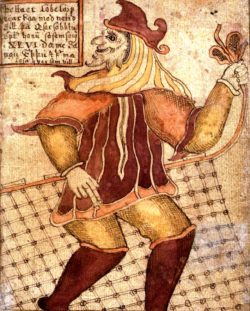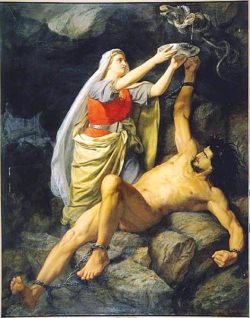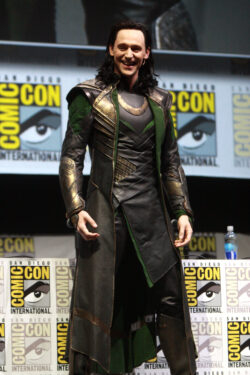Tinker, Tailor, Soldier, Sailor. Trickster, Taika, Loki, Thor.1
— Jerry Garcia

Taika Waititi
Photo: Gage Skidmore, Peoria, AZ, United States of America, CC BY-SA 2.0 <https://creativecommons.org/licenses/by-sa/2.0>, via Wikimedia Commons
I have a longstanding debate with a close friend over the question Can ANYTHING be made fun of? Is it possible to take NOTHING seriously? Trickster thinks so. And the universe has sent us filmmaker and actor Taika Waititi to test that theory. The markings of the Trickster are tattooed all over Waititi’s oeuvre, and his involvement with the Marvel Cinematic Universe begs a discussion that clarifies Trickster and highlights Waititi’s storytelling.
The Trickster as archetype, demigod or folklore figure exists in every culture. The Great American Tricksters are Wakdjunkaga of the Winnebago tribe…and Bugs Bunny. Just a few of the folks who retain a childlike playfulness and scrape the borders between mortality and Trickster divinity: Marcel Duchamp, who challenged art’s seriousness; Yoko Ono, the artist who wonders like a child; Mae West, with her bawdy feminism; The Marx Brothers, imposters of society’s doyens of seriousness; Abbie Hoffman, who launched playfulness into the dark heart of a nation at war.
And in the realm of the divine are Baubo, the ancient Greek goddess of mirth; Raven, of the Indigenous Pacific Northwest and Siberia; China’s Huli-jing, a nine-tailed female fox; and Eshù Elégba from West Africa. Together, the tales of Trickster gods help to explain this deeply intriguing and complex archetype.
Tricksters stumble from episodes of moral indeterminacy—Tricksters just want to have fun—to moral discovery. This is what makes them important to us today: Morality develops when we let go of it for a while, that we might discover new perspectives and break free from the bindings of doctrine.
Trickster gods loom large, are consequential. They’re revered and feared. They travel the spaceways of folklore and connect us to their heavens. Divine Tricksters and mortal tricksters interpret the mysteries of the universe as they themselves remain mysterious.
Norse god Loki is a genuine Trickster, but his saga also introduces the more vengeful, less playful, and confined Trickster of Europe. His story illustrates the binding of the Trickster and the Western laziness and fear that make Trickster into the devil, the court jester, or the fool.

Chief god and all-father Odin is flanked by two ravens: Muninn, representing memory or mind, and Huggin, thought. Daily, Huggin and Muninn reconnoiter the world and return in the evening to brief Odin. In Huggin and Muninn we recognize the Raven’s divinity, but their Trickster wings have been clipped. The Warrior has usurped the Trickster.[2] Shapeshifter, gender bender and a top-tier god, Loki and his miseries represents this shift.
In many cultures, Trickster invents the fishhook or net early in the story cycles. Loki designs a fishnet, which he then burns. But when he later angers the gods with mischief, they discover his fishnet design and use it to capture him. This is a classic example of the cartoonish plot device whereby Trickster is the architect of his own undoing.
Another story is of the Jötnar, giants who are rivals of the gods. Loki the boundary-crosser mingles with them. He even fathers his children through a giantess. Resentful of their exclusion from the gods’ table, the Jötnar seek vengeance.
Loki sides with the giants and tricks the goddess Idunn, the keeper of the Golden Apples of Immortality, into being captured, Apples and all. When he orchestrates this trick between the giants and the gods, the giants get a taste of immortality through the apples, while the eternals get a taste of the passage of time. This explains why the gods appear old, as when they lost their immortality, they aged until they were able to retrieve the Golden Apples.
The gods were not amused. Loki faced punishment for stealing the Apples and for causing the death of a giant. Justice was meted out for the benefit of the grieving giant’s daughter, Skadi. As penalty for his crimes, Loki had to tie one end of a rope to a Billy goat’s beard and the other to his own scrotum. He squealed in pain at this forced self-abuse, humiliated as compensation to Skadi.[3]
Then there is the story is of Baldr. He’s the perfect god, a golden child, handsome and good, and associated with the sun. But after nightmares predict that some harm will come to him, his mother Frigg gets everyone in heaven and earth, including animals and fire and water, to promise not to harm Baldr. Her attempt to outsmart the prophecy through absolute control annoys Loki, who gender-shifts, and as a woman, interrogates Frigg. He finds out that she neglected to get the oath from mistletoe, it seeming so harmless, and so Loki tricks the blind god Hod into killing Baldr with a mistletoe dart. In this way, Loki rebels against the suffocations of control, and restores the inevitability of accident and accident’s key role in rebirth.[4] Accident, a morally indeterminate event from which we might stumble into rebirth and moral discovery.

“Loki” by Mårten Eskil Winge (1890)
Yet the gods inflict Promethean torture on Loki. He is bound beneath the earth and lashed with the guts of his own children. Acidic poison, from a serpent—provided by Skadi no less—drips above him. His wife Sigyn is able to catch the drops with a dish, but whenever she has to empty it, he’s struck by the acid, causing him to thrash in agony, which explains earthquakes.
Thus, two elements that are out of character for trickster stories, resentment and punishment, have now moved front and center. To what can we attribute this?
There are two eras of Norse mythology, and two Loki’s. The main source of pre-Christian Norse myths is the Poetic Edda. Though written down between the 9th and 13th centuries, they tell older, pre-Christian tales. Prose Edda, on the other hand, was compiled and written by Snorri Sturluson in 1220, well into the Christian era and influenced by Christian values. That lens turns Loki darker and more demonic than the Loki who inhabits the earlier poems. “When Snorri writes that Loki is the ‘father of lies,’ an epithet that does not occur in the Poetic Edda, he doubtless knows that this is what Christians call Satan.”[5]
So through Sturluson the Norse gods are reborn in a Christian mold, no longer indigenously Scandinavian. The binding of Loki is a cautionary tale. Suppressing Trickster invites apocalypse when playfulness would have released the pressure and avoided, in this example, earthquakes.[6]
Pre-Christian Norse mythology portrays Loki the Trickster as a necessary component of life, death, and rebirth. Revisionist Loki, Satan. In Christianity’s and empire’s need for control, such a playful and wily character must be repressed. Indeed, in many tales, both Odin and Thor seem obsessed with devising punishments for Loki.[7] And Frigg, like Mary, exerts control to protect her son Baldr, a Christ-like figure.
Loki appears as a bird, a flea, a woman, a mare, a fire. His shape-shifting causes us to wonder what his true self is. Those made uncomfortable by such ambiguity feel compelled to demonize. But he seems to have the last word. He brings Ragnarök, the apocalyptic battle that kills off the gods. There follows a rebirth and a new reign of the six surviving young gods, including a resurrected Baldr. But there is no getting around the limiting portrayal of Loki as a cunning villain, and only a more holistic embrace of the myth reveals the wisdom of chaos on the road to rebirth and human progress.
Lewis Hyde advises “There is no way to suppress change, the story says, not even in heaven; there is only a choice between a way of living that allows constant, if gradual, alterations and a way of living that combines great control and cataclysmic upheavals. Those who panic and bind the trickster choose the latter path. It would be better to learn to play with him, better especially to develop styles (cultural, spiritual, artistic) that allow some commerce with accident, and some acceptance of the changes contingency will always engender.”[8]
Ultimately, this relates to the suppressive Puritanism that has influenced American culture for so long and whose harness may finally be slipping [or does the current makeup of the Supreme Court foretell a regressive tightening?]. Tricksters like Raven, Eshu, or Loki cross the boundaries between heaven and earth, between the gods and humans. They tear at the fabric of control to reveal chance, chaos, play, uncertainty…and very possibly, Utopia. They bring opportunities to make a world that is more than what we ordinarily perceive. But societies intent on notions of absolute good and evil, that bind the trickster, invite apocalypse.

Gage Skidmore, CC BY-SA 3.0 <https://creativecommons.org/licenses/by-sa/3.0>, via Wikimedia Commons
The Marvel Cinematic Universe struggles to break free of Hollywood’s version of the bindings—their discomfort with indeterminate morality, and their addiction to box-office-driven battles between good and evil.
Marvel’s Loki®, played by Tom Hiddleston, is in fact subjected to humiliations, and brings some of Trickster’s capricious nature to the screen—I can see him pulling off the betrayal of Idunn. And Loki® entertains through his unreliability as an ally, but ultimately can’t escape the Western straitjacket of villainy. He’s pressed into the bad guy role.[9] His desire to amass armies and rule as a tyrant renders him in the Christian satanic frame and not as the fun, intriguing, primal, morally indeterminate, and compulsively playful archetype. By emphasizing moral absolutism, where mischief morphs into evil, Marvel leans into the Sturluson version, a corruption of Tricksters who are more free to swim the waters of moral indeterminacy.
What the world needs now, as C.G. Jung states, is the more primal and inspirational Trickster, one with an “undifferentiated consciousness,”[10] and certainly a more humorous character. Stay tuned and see if Marvel lets go of the cash register long enough to bring such a chaotically playful and utopian Trickster to life in future episodes.
But wait, there’s more…
…and by all means, click ahead to Part 2!
|
[1] Spoilers coming up for JoJo Rabbit and Thor: Love and Thunder. [2] In Greek mythology, Zeus, symbolized by the eagle, deposes his father, Cronos the Crow. The eagle represents the warrior, social order established through conquest. The raven/crow’s social vision is more akin to utopian anarchy than imperial conquest. They suffer diminution, but still pester. Raven’s role mutates from the Indigenous Trickster, culture-hero, deity and creator to the Christian era advisor, court jester, and fool—still divinely playful, but clearly down several rungs. [3] Gaiman, Neil, Norse Mythology (New York: W.W.Norton, 2017), pp. 194-196. [4] Hyde, Lewis, Trickster Makes This World (New York: Farrar, Straus and Giroux, 1998), pp. 100-107. [5] Hyde, Lewis, pp. 100-107. [6] Hyde, Lewis, p, 172. [7] Gaiman, Neil, Norse Mythology (New York: W.W.Norton, 2017). [8] Hyde, Lewis, Trickster Makes This World (New York: Farrar, Straus and Giroux, 1998), p.107. [9] DC ran into the same problem with their demonically mischievous villain, Mr. Mxyzptlk. [10] In Radin, Paul, The Trickster: A Study in American Indian Mythology (New York: Schocken, 1956), pp. xxiii-xxiv). |

[Part 2] The Trickster tongue speaks comedy, and Marvel movies increase the dose every year, where comedy ranks second only to the CGI action. Consider Robert Downey Jr.’s Iron Man quips; Guardians of the Galaxy, Ant-Man, the recent Spider-Man films, and most certainly Deadpool movies. Putting the laughs first has made these some of the...
Haven’t seen the movie “Poor Things?” Want its surprises? Then GO SEE IT before you read this… and in the meantime, click the image below v v v A LITTLE PLUG FOR YOU BOOK CLUBBERS [CLICK!] In their 2018 period comedy The Favourite, Arizonan Emma Stone and Athenian Yorgos Lanthimos gave us clues of mischief...
HEY PLAYSTERS! Apropos of nothing, I want to share with you an excerpt from Disruptive Play: The Trickster in Politics and Culture. Well, not quite nothing. For the most direct route to Trickster essence is through its Great American Icon, Bugs Bunny. When I wrote Disruptive Play, not so long ago, I was certain that...